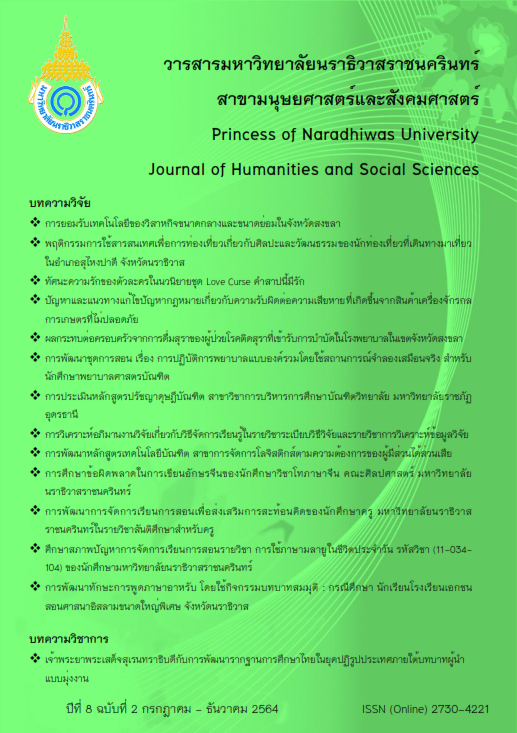Technology Acceptance of Small and Medium Enterprises (SMEs) in Songkhla, Thailand
Main Article Content
Abstract
The aims of this research were to compare level of technology acceptance by the size, sectors and types of SMEs in Songkhla province. The sample was 400 entrepreneurs, managers or executive staffs of SMEs in Songkhla. The research instrument was 5-point Likert scale questionnaire with the reliability of .956. Data was analyzed by frequency, percentage, mean, standard deviation, t-test and F-test. The results show that SMEs with differences in size, sectors and types have no differences in the level of overall performance expectancy, effort efficiency, social influence and facilitating conditions. However, considering by each items, SMEs with differences in sizes have differences in perceived usefulness and opportunity to generate income. SMEs with differences in industrial sectors have differences in accomplishing tasks more quickly. SMEs with differences in business types have differences in stakeholders’ influence. The Government agencies, SMEs and marketers can apply the research findings to promote and support the acceptance and use of technology of SMEs.
Article Details
References
ธมยันตี ประยูรพันธ์. (2561). การทดสอบโมเดลสมการโครงสร้างความพึงพอใจในการปฏิบัติงาน พฤติกรรมการเป็นสมาชิกที่ดีขององค์กร และพฤติกรรมการทำงานเชิงนวัตกรรมของพนักงานองค์กรวิสาหกิจขนาดกลางและขนาดย่อมในจังหวัดชายแดนใต้. วารสารมหาวิทยาลัยนราธิวาสราชนครินทร์ สาขามนุษย์ศาสตร์และสังคมศาสตร์, 5(2) 55-73.
นวรัตน์ ช่วยบุญชู, อรจันทร์ ศิริโชติ และเจษฎา นกน้อย. (2562). การยอมรับเทคโนโลยีและคุณภาพการบริการที่มีอิทธิพลต่อความจงรักภักดีของผู้ใช้บริการธนาคารอิเล็กทรอนิกส์. วารสารเศรษฐศาสตร์และบริหารธุรกิจ มหาวิทยาลัยทักษิณ. 11(1) 31-52
วันอามีนา บอสตัน อลี และสุมนา ลาภาโรจน์กิจ. (2562). ปัจจัยหลักที่มีอิทธิพลต่อการยอมรับใช้เทคโนโลยีการพาณิชย์อิเล็คทรอนิกส์ของผู้ประกอบการในโครงการ WOW สงขลา. วารสารวิทยาการจัดการ, 36(2) , 60-82.
ศิระ สัตยไพศาล และอนุพงศ์ อวิรุทธา. (2562). การยอมรับเทคโนโลยี คุณลักษณะความเป็นผู้ประกอบการ และโอกาสทางธุรกิจที่มีอิทธิพลต่อผลการดำเนินงานของธุรกิจสตาร์ทอัพ. วารสารวิจัยและพัฒนา วไลยอลงกรณ์ ในพระบรมราชูปถัมภ์ สาขามนุษยศาสตร์และสังคมศาสตร์, 14(3) 41-50.
สุชาติ ประสิทธิ์รัฐสินธุ์. (2550). ระเบียบวิธีการวิจัยทางสังคมศาสตร์ (พิมพ์ครั้งที่ 14.). กรุงเทพ: สามลดา.
สำนักงานส่งเสริมวิสาหกิจขนาดกลางและขนาดย่อม. (2562). จำนวนผู้ประกอบการตามนิยามใหม่. สืบค้น 18 กุมภาพันธ์ 2563, จาก https://app.Powerbi.com/view?r=eyJrIjoiZmUwZjYwYmYt OWE2ZS00ZmNmLWI5NTAtM2FiNzU5MzU2N2QxIiwidCI6ImExZmZjMjhhTEzZmMtNDhiMC05NGRmLWYyYWIyOGUwNWNhNSIsImMiOjEwfQ%3D%3D
AlSharji, A., Ahmad, S, Z., & Bakar, A, R. (2018). Understanding social media adoption in SMEs: Empirical evidence from the United Arab Emirates. Journal of Entrepreneurship in Emerging Economies, 10(2), 302-328.
Camilleri, M.A. (2019). The SMEs’ technology acceptance of digital media for stakeholder engagement. Journal of Small Business and Enterprise Development, 26(4), 504-521.
Nguyen, T.H., & Waring, T.S. (2013). The adoption of customer relationship management (CRM) technology in SMEs: An empirical study. Journal of Small Business and Enterprise Development, 20(4), 824-848.
Okundaye, K., Fan, S.K. & Dwyer, R.J. (2019). Impact of information and communication technology in Nigerian small-to medium-sized enterprises. Journal of Economics, Finance and Administrative Science, 24(47), 29-46.
Olatokun, W., & Bankole, B. (2011). Factors influencing electronic business technologies adoption and use by small and medium scale enterprises (SMEs) in a Nigerian municipality. Journal of Internet Banking and Commerce, 16(3), 1-26.
Orser, B., Riding, A. & Li, Y. (2019), Technology adoption and gender-inclusive entrepreneurship education and training. International Journal of Gender and Entrepreneurship, 11(3), 273-298.
Rogers, E.M. (1995). Diffusion of innovations (5th ed.). New York, NY: The Free Press.
Shahzad, A., Chin, H. K., Altaf, M., & Anwar, F. (2020). Malaysian SMEs performance and the use of e-commerce: A multi-group analysis of click-and-mortar and pure-play e-retailers. Pakistan Journal of Commerce and Social Sciences, 14(1), 1-33.
Shaw, N., & Sergueeva, K. (2019). The non-monetary benefits of mobile commerce: Extending UTAUT2 with perceived value. International Journal of Information Management, 45(1), 44-55.
Sila, I. (2013). Factors affecting the adoption of b2b e-commerce technologies. Electronic Commerce Research and Applications, 13(2), 199-236.
Venkatesh, V., Morris, M.G., Davis, G.B., & Davis, F.D. (2003). User acceptance of information technology: Toward a unified view. MIS Quarterly, 27(3), 425-478.
Yunis, M., El-Kassar, A. & Tarhini, A. (2017). Impact of ICT-based innovations on organizational performance: the role of corporate entrepreneurship. Journal of Enterprise Information Management, 30(1), 122-141.


